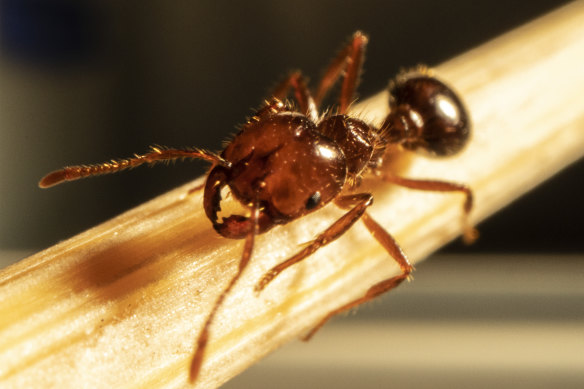This was published 1 year ago
‘Massive surveillance failure’: Fire ant infestation sparks fear of undetected spread
By Mike Foley
More than 100 nests of venomous fire ants have been discovered on an army base west of Toowoomba in Queensland, sparking warnings that the potentially deadly pest may be spreading across Defence Force sites.
A shock discovery of 78 fire ant nests was made at the Oakey air base, west of Toowoomba, last week. A further 32 nests have been found since.

Fire ant colonies have been found on Defence land west of Toowoomba in Queensland. Credit: National Fire Ant Eradication Program.
Fire ant bites typically cause a burning sensation that lasts up to an hour but in the worst cases can cause a fatal anaphylactic shock.
Fire ants have been detected in Melbourne and Hobart in the past year, and twice in NSW. None of those detections were as significant as the number of nests found at Oakey.
Authorities say the nest sites at Oakey were restricted to Defence land and insecticide has been used to treat them.
It can take years to fully eradicate a large infestation. Oakey is located within Australia’s most extensive inland river system, the Murray Darling Basin, and the ants have been known to spread via water-borne debris.
It is also possible the colonising ants have travelled between Defence sites on vehicles or aircraft.
A spokesperson for the national eradication program, led by the Queensland government, said it was conducting further eradication efforts and surveillance at Oakey.
“Further genetic testing, compliance and tracing investigations are continuing to determine if they may have spread and determine how the ants arrived in the area,” the spokesperson said.
Fire ants first arrived in Australia at Brisbane in 2001 via international shipping. The outbreak from that incursion is ongoing, with a National Fire Ant Eradication Program treating 8000 square kilometres around Brisbane and the Gold Coast to remove the pest.
Since the 2001 outbreak, fire ant colonies have been found and eradicated in Sydney, Gladstone and Fremantle.
Invasive Species Council fire ant expert Reece Pianta said it would have taken years for the fire ant colony at Oakey to grow to such a large size, revealing a “massive surveillance failure”.
“Defence facilities pose a high risk for spreading fire ants in cargo and vehicles to other locations in Australia. The federal government should rapidly audit all defence land for fire ants,” Pianta said.
Helen Scott-Orr, a former federal inspector-general of biosecurity reviewed the national eradication program in 2021. She warned that defence and other land managed by the Commonwealth government may slip through the cracks of the eradication program, which is jointly funded by the federal government but led by Queensland.
“Major rail and road corridors, Defence land, airports and ports are all at high risk of fire ant establishment. This could pose risks of continued fire ant spread,” Scott-Orr’s review said.
The eradication program will cost $592 million over the four years to 2027. Scott-Orr told a Senate inquiry last month that double that amount, up to $300 million a year, was needed to fund the eradication program adequately.
The Senate inquiry report called for a review of eradication funding and for a national awareness campaign to alert the public to the risks of fire ants and actions to limit their spread from infestation zones – like transport of organic material that could contain the pests.
Federal Agriculture Minister Murray Watt did not respond to questions about increased funding, or mounting an awareness campaign.
He said Australian governments were all helping the eradication effort in the nation’s largest joint-funded biosecurity effort.
Fire ants are native to South America and have colonised the southern United States, made their way to Australia several times through international shipping and are capable of forming colonies in 99 per cent of mainland Australia and 80 per cent of Tasmania.
The National Allergy Centre of Excellence, Australia’s peak allergy research body, estimated that a nationwide infestation of fire ants would sting up to 650,000 people a year. That figure includes up to 175,000 people who would suffer allergic reactions such as hives, welts and swelling that in severe cases could be fatal.
Cut through the noise of federal politics with news, views and expert analysis. Subscribers can sign up to our weekly Inside Politics newsletter.